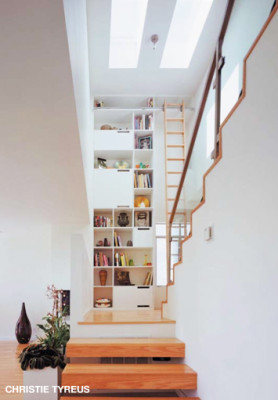By, Christie Tyreus, Marin Residential Designer.
Green home renovations are, in a word, daunting. Even when you have professionals on the job, there are still a lot of decisions to make on your own. What types of flooring should you consider? Do you want to replace your windows or try to incorporate the ones you already have? Where should you shop for materials? How you answer these types of questions has a major impact on how healthy it is to live in your renovated home and the impact your renovation has on the environment.
In my experience renovating client’s homes, there are three categories that will have a major impact on the success of any green home renovation:
- window design
- material selection
- purchase location (where you buy your project materials)
I consider these The Big Three, since your choices in these categories will make or break the success of a sustainable, healthy renovation. Just a little knowledge in these categories goes a long way. Green home renovation is much more about common sense and practical decision-making, not abstract science that you need a reference manual to decode.
For today’s post, I’ll discuss the first of the three categories: window design.
Want a healthy home? Windows do matter in green home renovation.
When reviewing potential changes to your current windows, either their placement, size, or type, consider this: smart window design allows for natural ventilation and controlled thermal gain (heat from the sun). Let’s break these two things down.
Natural Ventilation

A green home renovation uses north facing skylights that provide natural light for the great room below. (Christie Tyreus Design Studio)
The first consideration regarding windows for your green home renovation is to encourage natural ventilation whenever possible. The indoor air we breathe at home is typically far more polluted than our outdoor air. In fact, indoor air can be 10 times more polluted. What makes indoor air so unhealthy? Things like VOCs (chemical pollutants that have become airborne from products like paint, cleaning supplies, furniture or building materials), mold, pet dander, and radon end up in the air of our homes. These are things you do not want circulating throughout your home on a daily basis. Breathing these pollutants can affect us in many negative ways. Short-term exposure can result in headaches, dizziness, nausea, and a worsening of allergies or asthma. In laboratory animals, long-term exposure to certain VOCs has caused cancer and affected the nervous system. Indoor air quality is particularly significant for children, who breathe more rapidly than adults, and therefore ingest more air over a shorter period of time. The more fresh air you can introduce into the home, the better indoor air quality you will have.
To maximize your natural ventilation, which is key to any green home renovation, you want to place operable (able to open) windows directly across from one another in a room, and have them no farther apart than 20 feet. This will allow for a strong cross breeze that will help vent pollutants. It’s important to have more than one window open for good ventilation. Opening just one window in a room will result in very little airflow. It’s like blowing air into a plastic bottle vs. blowing air through a tube – the air needs a place to exit.
If you don’t have windows directly opposite one another, try adding a venting skylight. Velux makes several models that can be installed between your existing roof rafters. As long as your roof is in good condition, this is an easy install with huge benefits. With the skylight and windows open, you will get significant upward ventilation. This also allows naturally rising hot air to escape, which can help keep your home cool.
When deciding where your windows should be placed, you’ll want to keep in mind the prevailing wind direction around your home. Most of Marin and the greater Bay Area experiences a North or Northwest wind, which means the wind blows towards the South or Southeast. Putting your operable windows on these sides of your house (i.e. the north and south sides) will take advantage of a substantial amount of airflow and fresh air.
Control Heat Gain
The second factor to consider for your green home renovation is controlled heat gain. This simply means, don’t let the sun heat up your home when you don’t want it to get any hotter. If you can control the amount of heat coming in to your home, you can use less energy cooling it down and avoid using central air conditioning. This puts less strain on our natural resources and saves you money on your energy bill.
This is especially relevant in the summer and early fall in Marin. In the afternoon, our homes are getting quite warm. West facing windows allow the hot, afternoon sun to continue to warm up the home, usually past the point of comfort. And since the sun is setting in the West, it is always changing position in the sky, making overhangs or awnings not very helpful. The best solution is to simply limit the number and size of your West facing windows and make sure they are well insulated. Single pane, aluminum frame windows are an energy disaster. Make sure your new windows are double pane with a low-E or a high R value assigned to them by the manufacturer.
It’s ideal to have lots of windows facing South, provided that you create at least a 4’ overhang for adequate shading in the summer months. Deciduous trees are also quite effective, as their leaves will provide shade in the summertime, but will drop their leaves and allow for heat gain in the winter. North facing windows don’t get direct sunlight, so you don’t need to worry about shading, and East facing windows allow morning sun, which is usually preferred. Understanding the direction your windows face will help you use less energy and keep your home at a more comfortable temperature.
In conclusion, window design is an important part of green home renovation. As you can see, windows are doing more than just providing a view. Designing for significant natural ventilation, while limiting your home’s heat gain, will help you create a smart, comfortable, and healthy place to live.
For more information, take a look at these websites:
California’s Department of Resources Recycling and Recovery
Christie Tyreus’ Bay Area design studio creates renovations that are as sustainable as they are stylish, with creative solutions that address how families live today. Christie, who holds a master’s degree in architecture, has lectured at Philadelphia University on Sustainable Building Techniques and was a designer for Foundry Square, one of San Francisco’s first buildings to be awarded a LEED Platinum rating for sustainability.


